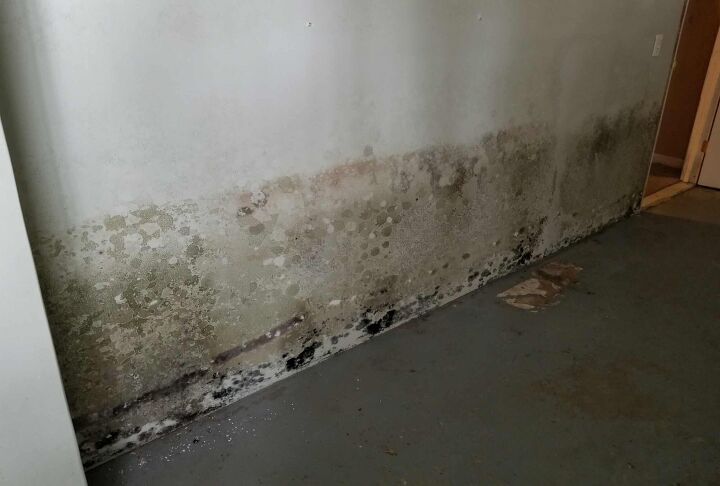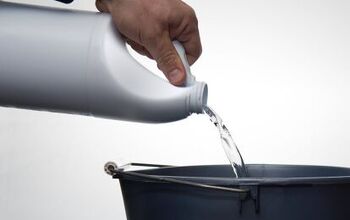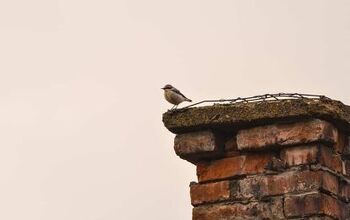How To Get Rid Of Mold In Your Basement (Quickly & Easily!)

If there is one single room in every home that tends to be prone to mold, it’s the basement. Basements are dark, cold, and often have leaks from the outside. This leads to a lot of issues, primarily mold. We’ve all been in basements that had that telltale musty, moldy smell. Sometimes, you might even see the mold growing up a wall. Did you ever wonder what you can do to get rid of that mold?
Getting rid of mold in your basement requires a thorough cleaning, as well as a way to keep mold from growing. To do this, follow the steps below:
- Dry out the area.
- Check to see the mold growth.
- Spray a mold-killing spray on the mold, and start scrubbing.
- Remove any items damaged by the mold.
- Fix any fixtures that have been damaged by mold.
- Address the problem that caused the mold in the first place.
There’s no ifs, ands, or buts about it. Mold is a serious issue that can eat away at your home, not to mention the health of people living inside of it. This guide will help you save your family from the dangers of mold.
Do You Need Mold Removal Services?
Get free, zero-commitment quotes from pro contractors near you.

Is This A DIY Project?
In most cases, getting rid of mold in your basement can be done on your own. However, there are always exceptions to the rule. If you have serious mold allergies or notice that the mold is extremely pervasive, you might need to have professional mold remediation done. Moreover, if the root cause of the mold is something that involves a leaky foundation or a sump that keeps flooding your basement, you might want to call a plumber.
The guide below is primarily focused on light mold problems. If you have serious mold issues that managed to penetrate sheetrock, or a major flood, do not use this guide. Call your homeowner’s insurance for flood insurance purposes, then get professional mold remediation. It’s far better to get the major stuff done via professionals, rather than to try to do it on your own.
How To Get Rid Of Mold In Your Basement
Now that we’ve gone over our disclaimer, let’s talk about what you can do to get rid of mold in your basement for good. Don’t worry, we’re going to be dividing the instructions into major sections, so that you can get it done easily.
First, Dry Out The Basement ASAP!
Before you can do anything else, you need to remove the source of water that’s been causing the moisture to build up. This means you will need to do the following:
- Figure out where the water is coming from. If it’s coming from a leaky pump or a bad pipe, shut off the water and call a plumber immediately. If you need to, call your homeowner’s insurance, too.
- Grab some towels and soak up any extra moisture. Do whatever you can to get rid of the water. If it means that you need to sop up moisture with towels, so be it. You can also use a wet vacuum to remove it, or a siphon, if you need to.
- Dry out the area more by getting a space heater or a hairdryer. Make sure that you plug it into an area that has not been affected by water. If you cannot do this, get a battery-powered one.
- If the flood is very recent, call the insurance company immediately. They may be willing to cover water damage, though mold damage isn’t usually covered.
Check To See Where The Mold Growth Is
You want to take a close look at the following factors when you start your mold remediation:
- Mold Type. If it’s caked on, you’ll have an easier time. If it’s powdery, you will have to re-wet it while you’re scrubbing. We’ll get into that later.
- Location. Mold growth on sheetrock is going to be different than mold growth underneath laminate flooring or furniture.
- Quantity. If you let the mold grow until it’s seriously impacted the quality of air in your basement or if a large portion of your home is ruined, call a professional.
Spray A Mold-Killing Spray And Scrub Away
Not all mold can be killed with the same equipment. There are several different ways that you can get rid of the mold. Here’s what you need to know about each:
- White Distilled Vinegar. White distilled vinegar can get rid of black mold and is actually pretty good as a mold killer. To use this, spray the vinegar directly on the mold and let it sit. Then, take a hard bristle brush and scrub away. The mold should fall off.
- Bleach. If you are dealing with sheetrock or other heavy-duty stuff, you can use bleach to kill all mold types. It’s worth noting that this can damage wood, laminate, and most other items. Avoid using it on sheetrock. But, if you have sturdy items or mold growing on laminate or rubber, bleach away. We suggest using a diluted bleach (1 cup bleach per gallon of water), then wiping it off after two minutes.
- Mold Killer. There are several brands of cleaning agents that are specifically designed for mold remediation. These can work wonders for people who want to get an all-around fungicide.
Once you’ve sprayed down the area and scrubbed away, wipe the area down with a damp cloth and pat it dry.
Remove Any Items Damaged By Mold
Mold is a living organism that feasts on the stuff in our homes—food, furniture, books, everything. If you have small items or papers that have been affected by the mold, you should remove them immediately. In most cases, you will be best off clearing out the entire room affected by mold.
When you’re cleaning out the room, it’s best to sort items into three piles: destroyed, salvageable, untouched. Anything that is destroyed should be taken to the local dump or recycling center. Salvageable items can be fixed or tossed on a case-by-case basis.
Fix Any Fixtures Damaged By Mold
With that said, there are some occasions where you might be able to save and restore items affected by mold. Some items that are considered to be prime restoration options include:
- Furniture. Wooden furniture can be restored if you are willing to sand away the portion eaten away by mold. You will need wood filler and a wood stain, but it’s still possible.
- Ceramic. Soaking ceramic in white vinegar will remove the mold and the stains.
- Plastic. Most plastics will be easy to wipe down. Just make sure it’s not porous!
- Sheetrock/Walls. If you have mold-damaged walls, you will need to call professional mold remediation crews to fix this. Either way, you will need to address this to prevent mold from re-entering your room.
Note: You still need to remove the restorable items from the room and treat them to continue your clean-up. When they’re mold-free, you can re-introduce them to the room.
Address The Problem That Caused The Mold In The First Place
Obviously, there is always the chance of having a one-off calamity like a flood or a blown pipe. However, these are usually in the minority when it comes to serious mold issues. More often than not, mold cases are caused by long-term issues like a slow leak or a poorly ventilated basement. These tasks below can help reduce the problem from recurring:
- Have a plumber take a look at everything in your basement. If you had repeated floods in your basement, an inspection by a plumber is a must. You might have a leak you aren’t aware of. Should this be the case, the mold will continue to form as long as the leak is present.
- Get a dehumidifier. If it’s a matter of excess moisture in the air, a dehumidifier can help reduce it. However, there is a more permanent option you should consider getting if you have the chance…
- Improve your ventilation. Sometimes, you may need to find a way to improve your basement’s ventilation. Bad ventilation can cause condensation to build up in rooms. In a basement, this means that you might end up with cold, clammy areas prone to mold.
- Check your pets. Sometimes, the reason for mold deals with pets. Many pets, including unneutered cats and dogs, will spray urine on walls in order to mark territory. If this is the case with your pets, it may be a good time to call your vet.
- If your floor was impacted by a flood, check for mold. This is only a must-do if you have laminate, vinyl, or “stick-on” tiling. Mold tends to build up underneath tile, especially after a flood. Lifting up a tile or having a professional take a look at things is a must.
How Much Does Professional Mold Remediation Cost?
If your mold has gotten to the point that you need professional help, you need to brace yourself. This is not a cheap service, even if the area that it’s affected is pretty small. Most professional mold remediation jobs will cost between $500 to $6,000 or more depending on the size of the area and the depth of the infestation.
Most basement mold remediation services will cost on the higher end of the spectrum. This is primarily because the messes that occur in basements tend to be far larger than what you might see in a bathroom or a kitchen. After all, you tend to notice leaks in those rooms more quickly.
Do You Need Mold Removal Services?
Get free, zero-commitment quotes from pro contractors near you.

Related Questions
Can white distilled vinegar kill black mold?
Yes, it can. In a recent study, scientists discovered that regular white vinegar is powerful enough to kill over 80 percent of molds commonly found in homes. This includes black mold. So, if you discover black mold in your drinkware or on your home’s walls, it’s safe to say that you can remove it with some vinegar.
What does mold smell like in a basement?
There’s a distinct odor that mold gets when it’s in a basement. Many people will say that it’s musty, while some might say it’s more like the smell of a bath mat or the scent of an old pool area. The best way we can explain it is that it smells wet and gross.
How fast can mold grow in a damp basement?
Mold can grow pretty quickly when it’s in the right conditions, and a damp basement definitely fits that bill. When left in a cold, dark, and damp area, it’s possible for mold to start growing in as little as 24 to 48 hours. The longer the area remains damp, the more likely it is that mold will grow there.This is why it’s so important to make sure that your basement avoids too much moisture and doesn’t get any leaks. It can quickly turn into a moldy mess.

Ossiana Tepfenhart is an expert writer, focusing on interior design and general home tips. Writing is her life, and it's what she does best. Her interests include art and real estate investments.
More by Ossiana Tepfenhart



























